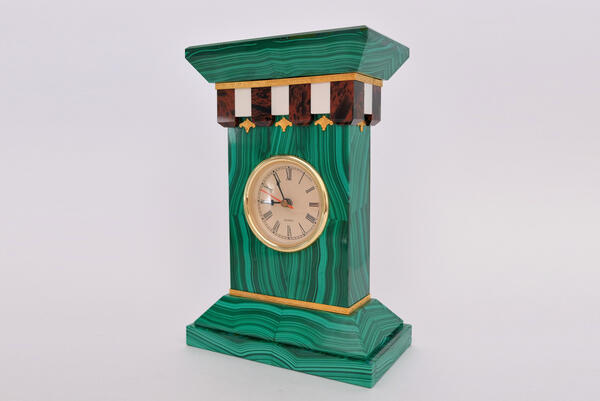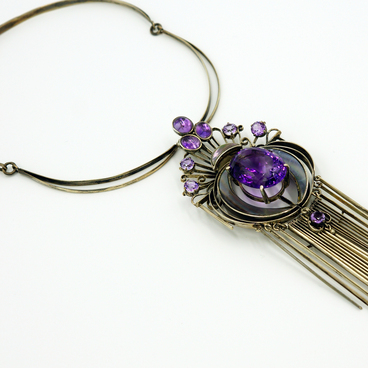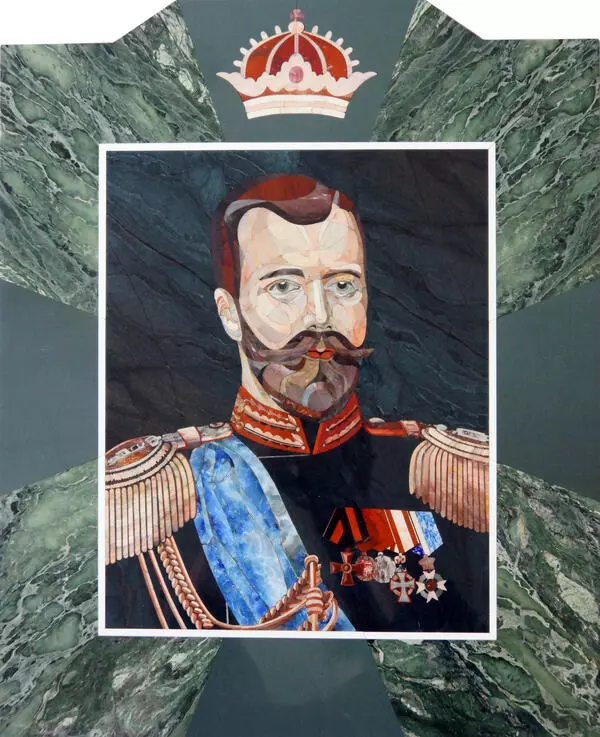In the 20th century, masters of the Sverdlovsk plant “Russkiye Samotsvety” (Russian Gemstones) began to revive the traditions of Ural stone-cutting art, including Russian mosaics. This technique involved laying out a pattern of thin stone plates, fitting them tightly together, and filling the seams with a special paste, making them invisible. It was used to decorate large objects that could not be carved from a single stone block.
In the 1990s, artist and engineer Natalia Bebko designed the so-called “cabinet set”. It included a vase, a clock and two candlesticks.
The clock from this set is displayed in the Museum of Stone-Cutting and Jewelry Art History. It has a rigid geometric shape: the central part is rectangular, while the upper and lower parts are cut in the form of identical prisms.
For this piece, masters of “Russkiye Samotsvety” plant chose African malachite. It differs from the Ural malachite: the surface does not have a bluish hue, and the pattern consists of clear contrasting circles or stripes, whose color can vary from light green to almost black.
The upper part of the clock is decorated with a broad ornamental band of red jasper and white cacholong plates. Gilded inlays are placed between them.
Malachite is an ornamental stone. According to one theory, its name derives from the Greek word “molokhe” — “mallow”. Its coloring resembles the dark green color of the leaves of the mallow plant.
In the 19th century, malachite was commonly called the “Russian stone”. The famous Ural deposits, especially the Gumeshevskoye and Mednorudyanskoye deposits, were the main suppliers of this stone in the world. Presently, there is no industrial mining of malachite in the Urals, as its reserves are exhausted. Nowadays, the main source of this stone is the so-called Central African Copperbelt, which stretches across the territories of Congo and Zambia.
The Democratic Republic of Congo is the main supplier of malachite in the world. However, smaller deposits are located in Namibia, the United States, and Kazakhstan.
In the 1990s, artist and engineer Natalia Bebko designed the so-called “cabinet set”. It included a vase, a clock and two candlesticks.
The clock from this set is displayed in the Museum of Stone-Cutting and Jewelry Art History. It has a rigid geometric shape: the central part is rectangular, while the upper and lower parts are cut in the form of identical prisms.
For this piece, masters of “Russkiye Samotsvety” plant chose African malachite. It differs from the Ural malachite: the surface does not have a bluish hue, and the pattern consists of clear contrasting circles or stripes, whose color can vary from light green to almost black.
The upper part of the clock is decorated with a broad ornamental band of red jasper and white cacholong plates. Gilded inlays are placed between them.
Malachite is an ornamental stone. According to one theory, its name derives from the Greek word “molokhe” — “mallow”. Its coloring resembles the dark green color of the leaves of the mallow plant.
In the 19th century, malachite was commonly called the “Russian stone”. The famous Ural deposits, especially the Gumeshevskoye and Mednorudyanskoye deposits, were the main suppliers of this stone in the world. Presently, there is no industrial mining of malachite in the Urals, as its reserves are exhausted. Nowadays, the main source of this stone is the so-called Central African Copperbelt, which stretches across the territories of Congo and Zambia.
The Democratic Republic of Congo is the main supplier of malachite in the world. However, smaller deposits are located in Namibia, the United States, and Kazakhstan.




